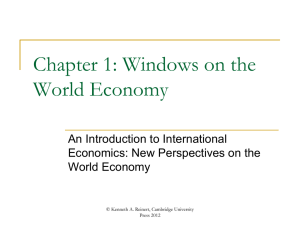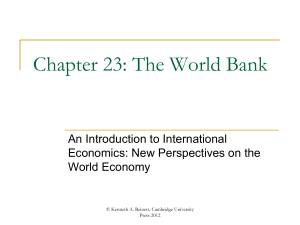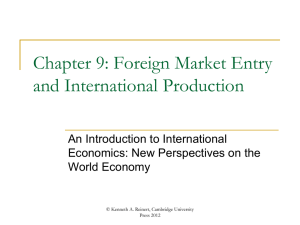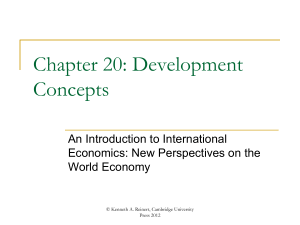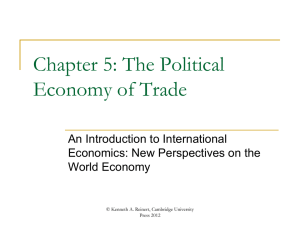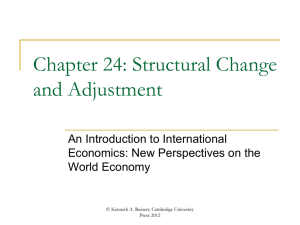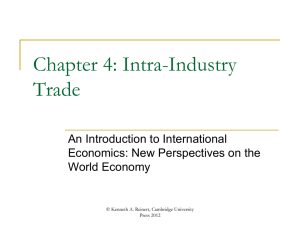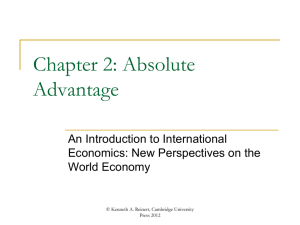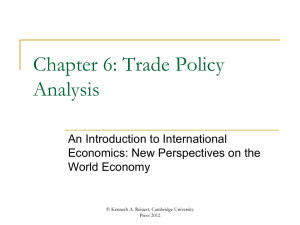Chapter 21. Growth and Development.
advertisement
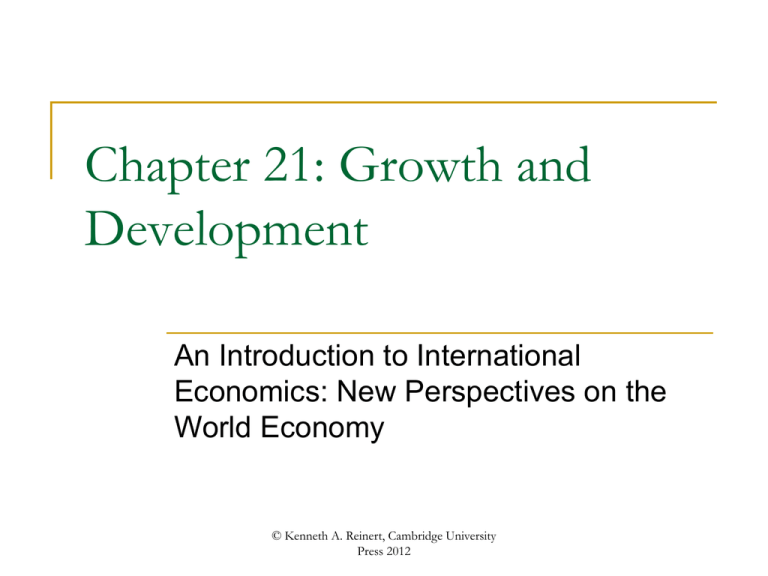
Chapter 21: Growth and Development An Introduction to International Economics: New Perspectives on the World Economy © Kenneth A. Reinert, Cambridge University Press 2012 Analytical Elements Countries Factors of production © Kenneth A. Reinert, Cambridge University Press 2012 Introduction Economists are increasingly concerned with explanations of per capita GDP levels and their rates of growth For such explanations, economists turn to what is known as growth theory Here we consider two variants of growth theory “old” growth theory or the Solow model “new” or “endogenous” growth theory We also consider the inter-relationships among human capital, trade, institutions and growth An appendix to the chapter presents some of the algebraic details of growth theory © Kenneth A. Reinert, Cambridge University Press 2012 Robert Solow: Originator of Modern Growth Theory © Kenneth A. Reinert, Cambridge University Press 2012 Old Growth Theory: Production Function Growth theory began with Nobel Laureate Robert Solow (1956) in what is now known as “old” growth theory Growth theory uses what economists call a production function, in particular, the intensive production function illustrated in Figure 21.1 The intensive production function relates two economic variables Per capita GDP denoted by 𝑦 = 𝑌 𝐿 where 𝑌 is GDP and 𝐿 is the labor force/population The capital-labor ratio denoted by 𝑘 = 𝐾 𝐿 where 𝐾 is the total amount of physical capital © Kenneth A. Reinert, Cambridge University Press 2012 Old Growth Theory: Production Function Figure 21.1 indicates that there is a positive relationship between the capital-labor ratio and per capita GDP As the capital-labor ratio increases and each worker has more physical capital to work with, per capita GDP increases This is a process known as capital deepening Figure 21.1 also indicates that the relationship between the capital-labor ratio and per capita GDP is decreasingly positive (the slope of the graph becomes flatter as increases) This is the result of diminishing returns to labor and capital © Kenneth A. Reinert, Cambridge University Press 2012 Figure 21.1: Intensive Production Function and Capital Deepening © Kenneth A. Reinert, Cambridge University Press 2012 Old Growth Theory: Technological Change There is a set of other possible source of increases in per capita income Solow had referred to this as technological change, but this turns out to be only one possible shift factor This we will refer to as shift factors because they shift the intensive production function as in Figure 21.2 As a result of these shift factors, at a given capital-labor ratio, 𝑘1 , per capita income increases from 𝑦1 to 𝑦2 Increases in per capita incomes can come about through increases in the capital-labor ratio (capital deepening) or through other shift factors such as improvements in technological efficiency © Kenneth A. Reinert, Cambridge University Press 2012 Figure 21.2: Technological Change in the Intensive Production Function © Kenneth A. Reinert, Cambridge University Press 2012 How Fast Can Countries Grow? How fast can increases in capital-labor ratios or other shift factors make economies grow? As you see in Table 21.1, growth rates in GDP per capita can differ significantly among countries and over time The variation recorded in this table alone ranges from minus 7 percent (Haiti in 2010) to 16 percent (China in 1970) It is important to keep in mind that when poor countries record negative growth rates, poverty is most likely increasing In the case of Ghana, you can see that in 1980, 1990 and 2000, the growth rate was very low In 2010, however, it had increased to 5 percent © Kenneth A. Reinert, Cambridge University Press 2012 Table 21.1: Growth in GDP Per Capita (percent) Growth Rate in GDP Per Capita Country GDP per capita, 2010 1970 1980 1990 2000 2010 Ethiopia 358 NA NA -1 3 8 Haiti 664 NA NA NA -1 -7 Ghana 1,319 7 -2 1 1 5 India 1,375 3 4 3 2 8 Indonesia 2,952 5 6 7 4 5 China 4,433 16 6 2 8 10 Costa Rica 7,774 5 -2 1 0 3 Turkey 10,050 6 7 -6 3 7 Brazil 10,993 1 -5 7 5 8 South Korea 20,540 6 -3 8 8 6 Spain 30,026 3 2 4 4 0 Japan 43,063 -2 2 5 2 5 United States 46,702 -1 -1 1 3 2 © Kenneth A. Reinert, Cambridge University Press 2012 The Process of Capital Deepening Increases in k require increases in the capital stock that more than offset any increases in population Increases in the capital stock, in turn, require investment Finally, investment requires saving The relationship between saving and investment developed in Chapter 13 was 𝐼 = 𝑆𝐻 + 𝑆𝐺 + 𝑆𝐹 Or in words Domestic Investment = Domestic Savings + Foreign Savings In the absence of shift factors such as technological improvements, increases in domestic and foreign savings are the only sources of growth in per capita incomes © Kenneth A. Reinert, Cambridge University Press 2012 Solow Residuals As represented in Figure 21.3, the Solow model leaves a lot to be explained The double-headed arrow in this diagram represents the amount of growth not accounted for by capital deepening This is known as the Solow residual In practice, Solow residuals can be large New growth theory attempts to explain some of these Solow residuals © Kenneth A. Reinert, Cambridge University Press 2012 Figure 21.3: Unexplained Growth in Per Capita Income © Kenneth A. Reinert, Cambridge University Press 2012 New Growth Theory The models of the new growth theory are varied A number of new growth theory models emphasize the role of a third factor of production in addition to labor and physical capital, namely human capital Because productive knowledge can be embodied in workers, there appears to be a positive link between human capital and technological efficiency This lead to a modification of the intensive production function so that increases in human capital shift it upward through a positive impact on technological efficiency © Kenneth A. Reinert, Cambridge University Press 2012 Human Capital As is shown in Figure 21.4, levels of human capital can vary significantly among countries and over time Outside of sub-Saharan Africa, adult literacy rates are on significant upward trends, although this trend has also recently halted in South Asia Figure 21.4 plots adult literacy as a measure of human capital for a range of years and for five developing regions Literacy rates vary significantly, from just over 60 percent in South Asia to over ninety percent in the Latin America/Caribbean and East Asia/Pacific regions The view of new growth theory is that such differences can matter for technological efficiency and, therefore, GDP per capita © Kenneth A. Reinert, Cambridge University Press 2012 Figure 21.4: Adult Literacy Rates by Region (percent) 100 90 90 91 94 86 80 80 76 68 70 63 62 58 57 60 percent 91 56 53 50 46 40 30 20 10 0 Sub-Saharan Africa South Asia Middle East & North Africa 1990 2000 Latin America & Caribbean 2010 © Kenneth A. Reinert, Cambridge University Press 2012 East Asia & Pacific Human Capital and Growth In the intensive production function of new growth theory, technology is an endogenous variable that can be influenced by levels of human capital measured perhaps as literacy rates or years of education The implication of this can be seen in Figure 21.5 In this figure, an increase in human capital from period 1 to period 2 shifts the intensive production function upwards The amount of unexplained growth from Figure 21.3 (the Solow residual) declines, and changes in human capital are an important component in this decline © Kenneth A. Reinert, Cambridge University Press 2012 Figure 21.5: Human Capital and Unexplained Growth in Per Capita Income © Kenneth A. Reinert, Cambridge University Press 2012 Empirical Evidence Early attempts to address this possibility indicated the human capital was empirically important However, subsequent work questioned the empirical importance of human capital as education in explaining development as growth One suggestion was that it is difficult to establish the role of education in growth due to measurement errors Recent studies seem to have resolved the measurement error difficulties by establishing a non-linear relationship between education and human capital Once this is done, it appears that education does indeed contribute to development as growth © Kenneth A. Reinert, Cambridge University Press 2012 Rate of Return to Education Further evidence on the importance of human capital in the form of education comes from research on the rate of return to education (RORE). Standard results from this body of research suggest that: The private/market RORE is generally higher than the rate of return on physical capital investments The private/market RORE is generally higher at lower levels of education The private/market RORE is generally higher at lower levels of GDP per capita There is also a growing body of research looking at female education that suggests that the human capital of girls and women is particularly important © Kenneth A. Reinert, Cambridge University Press 2012 Human Development and Growth It is important to recognize that human capital includes health and well as education Because of women’s traditionally close relationship to children, the educational levels of women contributes positively and significantly to child health There can be some important relationships among the three components of the human development index (HDI) presented in Chapter 20 that are illustrated in Figure 21.6 © Kenneth A. Reinert, Cambridge University Press 2012 Human Development and Growth Education has a direct impact on the HDI through its one-third weight and an indirect impact on the HDI via its impact on human capital and, thereby, on per capita GDP Health also has a direct impact on the HDI through its one-third weight and an indirect impact on the HDI through human capital and per capita GDP These indirect effects can be all the more powerful because, in addition, there is a two-way, positive interaction between education and health illustrated in Figure 21.6 © Kenneth A. Reinert, Cambridge University Press 2012 Figure 21.6: Education, Health, Growth, and Human Development © Kenneth A. Reinert, Cambridge University Press 2012 Trade and Growth Many development and trade economists have suggested that countries’ openness to international trade has a positive impact on growth in per capita GDP and, therefore, on poverty alleviation and human development This argument actually has a number of components Increased exports can support increased employment and wage incomes, with the latter being reinvested in increases in human capital Increased trade (both imports and exports) can in some circumstances improve competitive conditions in domestic markets Exports can contribute to improved technological efficiency as a shift factor in the intensive production function diagram © Kenneth A. Reinert, Cambridge University Press 2012 Trade and Growth: Technological Efficiency Technological efficiency responds to two impulses The first impulse is domestic innovation, which is positively affected by human capital accumulation in some new growth theory models The second impulse is the absorption of new technology from the rest of the world Therefore, exports are sometimes seen as having a positive externality for the exporting country Exports generate additional technology gains on the supply side of the economy © Kenneth A. Reinert, Cambridge University Press 2012 Export Externalities Potential export externalities are considered in the absolute advantage diagram of Figure 21.7 𝑃𝐺 is Ghana’s autarky price, and 𝑃𝑊 is the world price Without a positive export externality, as the price increases from 𝑃𝐺 to 𝑃𝑊 in the movement from autarky to trade, quantity supplied increases from point A to point B, and exports of 𝐸 𝐺1 appear In the presence of export externalities, the initial export level, 𝐸 𝐺1 , improves production technology and makes possible an increase in supply or a shift in Ghana’s supply curve from 𝑆 𝐺1 to 𝑆 𝐺2 Given 𝑃𝑊 , Ghanaian firms move from point B to point C, and exports expand to 𝐸 𝐺2 © Kenneth A. Reinert, Cambridge University Press 2012 Figure 21.7: Export Externalities for Ghana © Kenneth A. Reinert, Cambridge University Press 2012 Evidence of Export Externalities Export externalities are often justified with the historical experience of East Asia More formally, early studies in the 1990s deployed statistical techniques to show that the more open countries are to international trade, the faster their growth in per capita GDP More recent studies based on extended and improved indicators do seem to support the trade and growth link However, there is a lot of variance around this general relationship that needs to be kept in mind In individual countries with certain characteristics (e.g., confict), the trade and growth link can be absent © Kenneth A. Reinert, Cambridge University Press 2012 Institutions and Growth Increasing recognition has gone to the role of institutions in growth as an additional shift factor in the intensive production function diagram Table 21.2 presents some relevant institutional categories and their potential contributions to growth These include Rule of law Property rights Contract enforcement Regulation Social insurance © Kenneth A. Reinert, Cambridge University Press 2012 Table 21.2: Institutions and Growth Category Elements Relevance Rule of law Political representation Elections Independent judiciary Civil liberties Consistency Prevents violent conflict and provides for legitimacy in political decision-making Property rights Secure ownership or control of assets Right to returns on assets Asset distribution Ensures that the use of productive assets will result is appropriable returns that will, in turn, provide incentives for further development and use Contract enforcement Contract design Escape clauses Recourse Allows for parties to enter into long-term, productive arrangements with a minimum degree of certainty Regulation Prudential regulation of finance Macroeconomic management Health and safety regulation Addresses well-known instance of market failure Social insurance Transfer payments Employment practices Traditional social arrangements Ensures that market dislocations are managed so as not to impede human development Source: Rodrik (2007) and others © Kenneth A. Reinert, Cambridge University Press 2012 Growth Theory Algebra Growth theory begins with what economists call a production function: 𝑌 = 𝐴 × 𝐹 𝐿, 𝐾 This equation presents what is known as the aggregate production function In this equation 𝑌 is total output and total income 𝐿 is the aggregate labor force 𝐾 is the aggregate stock of physical capital 𝐴 refers to an exogenous measure of technology © Kenneth A. Reinert, Cambridge University Press 2012 Growth Theory Algebra Old” growth theory assumes that production takes place according to constant returns to scale Constant returns to scale means that a doubling of both 𝐿 and 𝐾 will lead to a doubling of 𝑌 More generally, multiplying both 𝐿 and 𝐾 by some constant 𝜃 will increase 𝑌 by that same factor In other words 𝜃𝑌 = 𝐴 × 𝐹 𝜃𝐿, 𝜃𝐾 If we set 𝜃 = 1 𝐿 , then 1 1 1 𝑌 = 𝐴 × 𝐹 𝐿, 𝐾 𝐿 𝐿 𝐿 © Kenneth A. Reinert, Cambridge University Press 2012 Growth Theory Algebra We define the terms of the last equation on the previous slide as GDP per capita or 𝑦 = 𝑌 𝐿 A constant in the form of 𝐿 𝐿 = 1 Physical capital per capita or 𝑘 = 𝐾 𝐿 This gives us the intensive form of the production function used in old growth theory or the Solow model 𝑦 =𝐴×𝑓 𝑘 New growth theory works with a modification of this intensive form of the production function that includes per-capita human capita (ℎ) 𝑦=𝐴 ℎ ×𝑓 𝑘 © Kenneth A. Reinert, Cambridge University Press 2012
